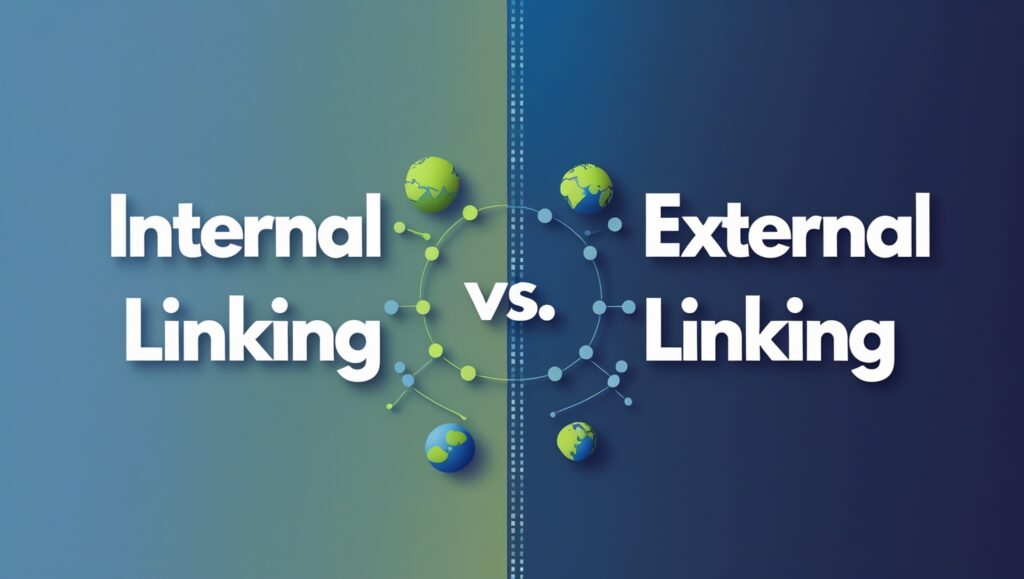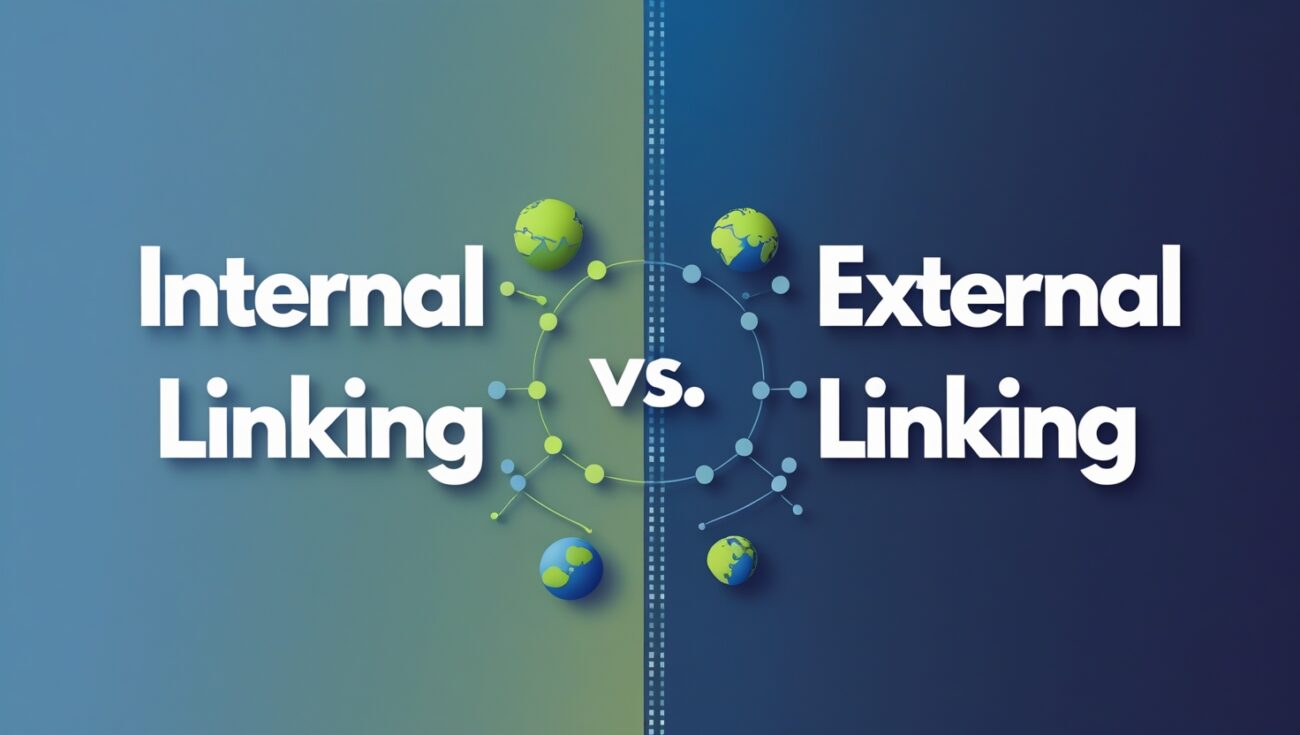Internal Linking vs. External Linking: What’s More Important?
It’s one of the oldest debates in the SEO world: internal linking vs. external linking (or backlinks). The truth is, most people are obsessed with backlinks. They spend countless hours and thousands of dollars trying to get a link from a big website, believing that it’s the only way to get a “vote of confidence” from Google. For years, I was one of those people. I spent so much time on backlinks that I completely neglected the most controllable, high-impact part of the equation: my own website.

Table of Contents
I’ve since learned that this debate is a false choice. They are both incredibly important, but they serve two very different purposes, and one of them should always come first. If you’re ready to cut through the SEO hype and start building a strong, sustainable website, this guide is for you.
The Case for External Links
An external link, or backlink, is a link from another website to yours.
- The Benefit: An external link is a powerful “vote of confidence” from another website. It tells Google that your website is a trustworthy, authoritative resource. These links are essential for building domain authority and ranking for highly competitive keywords. A link from a major news site, for example, can send a powerful signal to Google about your expertise.
The Case for Internal Links
An internal link is a link from one page on your website to another.
- The Benefit: This is where you have all the power. Internal links are completely within your control. You don’t have to beg, buy, or wait for them. A smart internal linking strategy is the most effective way to build a logical website structure, direct the flow of link equity (authority) to your most important pages, and improve the user experience.
The Verdict: A Complementary Relationship
The debate isn’t about which is more important; it’s about understanding how they work together.
- The Analogy: Think of a house. The external links are the power lines coming into your house. They provide the raw electricity (authority) that powers your entire site. The internal links are the wiring inside your house. They are what distribute that power to every room (page) in your home. Without good internal wiring, the power from the external links is useless.
The Internal Linking Advantage: Control and Speed
Advantage #1: You Are in Control
This is the most powerful reason to prioritize internal linking. You don’t have to beg or buy a link. You can audit, fix, and build your entire internal link structure right now, on your own terms. It’s an instant, high-impact SEO fix that you control completely.
Advantage #2: Faster Results
A comprehensive internal linking audit can lead to a quick, noticeable improvement in rankings. By fixing broken links, rescuing orphan pages, and building a stronger website structure, you can see results in a matter of weeks, not months or years. A tool can find all of your internal linking errors in minutes so you can start fixing them immediately.
Advantage #3: It Amplifies External Links
A good internal structure makes your external links more powerful. When a backlink comes in, a strong internal structure ensures that the authority from that backlink is distributed to your most important pages. It’s like having a built-in amplifier for all of your external links. Ready to stop guessing and start building a high-ranking website today? Discover how Linkbot can help you.
Stop Wasting Time, Start Building Your Foundation
I wasted years focusing on external links before I had a strong internal linking foundation. Don’t make the same mistake. Internal linking is the groundwork that makes all of your other SEO work worthwhile. It’s the first and most important step to building a high-ranking, successful website. Don’t wait. Start building your perfect SEO foundation today.
My journey taught me that a major mistake is seeing SEO as a mystery. By implementing a smart, corrective approach to my website, I made the mental shift from being a spectator to an active participant in my website’s success. This simple realization took the overwhelm out of SEO and turned it into a series of logical, manageable steps that I could control.
The long-term, compounding effect of fixing these mistakes is what makes it so powerful. Each time you add a thoughtful, relevant link, you are not just performing a task; you are building your website’s authority, one link at a time. These small, consistent improvements add up to a significant competitive advantage over the long term, making your website an increasingly powerful asset.
I can say from personal experience that there is a special kind of satisfaction that comes from seeing a direct correlation between a new link and a ranking boost. It’s the feeling of taking a tangled mess and organizing it into a clean, logical network. The result is a website that just feels better to navigate, for both users and the people managing it.
A clean internal link profile also has a huge impact on your website’s overall trustworthiness and authority. When a user or a search engine bot lands on your page and sees a clear network of interconnected, relevant articles, it signals that you are a serious, comprehensive resource on the topic. This kind of professional organization is exactly what Google looks for.
The most important part of this foundational skill is building a consistent habit of linking. It’s not about a single audit and then forgetting about it. A good website is a living thing, and it needs regular maintenance to ensure your internal links stay clean, which is a key part of long-term SEO success.
I felt like I was finally in the driver’s seat of my SEO. For years, I had relied on external factors, which felt like I was giving up control of my SEO destiny. But by mastering a simple task like building my internal links, I was proactively building my site’s authority from the inside out, on my own terms, which was an empowering and exciting feeling.
By implementing a strategy that serves both SEO and conversions, you are also directly addressing Google’s E-E-A-T framework. You are demonstrating expertise by creating topical clusters, you are showing authority by linking from strong pages, and you are providing a better user experience, which is a key part of what Google looks for in a trustworthy website.
I’ll never forget the first time I applied my new internal link strategy to a page that was struggling to rank, and it shot up in the search results almost overnight. This was my “aha” moment. I realized that a strategic, well-placed link from a high-authority page was far more powerful than I ever thought possible.
One of the greatest benefits I got from using an automated tool to manage my link profile was the “to-do” list it provided. Instead of being overwhelmed by the sheer size of my website, the tool gave me a prioritized, actionable list of fixes to make. It transformed a monumental, frustrating task into a series of manageable steps that I could tackle in just minutes.
It’s crucial to understand the difference between a simple, generic link and one that’s part of a strategic, mapped plan. A simple link is a one-off connection. A link that’s part of a plan is a purposeful part of a larger network, designed to pass authority and guide a user. The latter is far more powerful.
Ultimately, mastering internal linking is a simple but powerful strategy that transforms a website’s foundation. It’s a low-cost, high-impact fix that can instantly improve your site’s health and SEO performance. It’s the kind of foundational SEO work that every website owner should prioritize.
My final piece of advice is to not be intimidated. Don’t worry about the high cost of manual labor; just focus on making your website a better place for your readers. You will be amazed at the progress you make and the results you can achieve.

